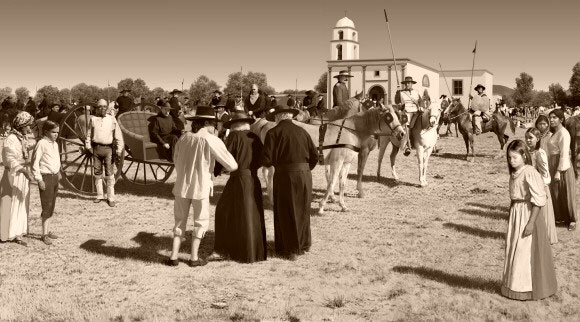
"I found this list in the Summer 2010 issue of Company – a jesuit magazine and thought I’d share it with you. [Update: The list comes from James Martin S.J.'s best-selling, The Jesuit Guide to Almost Everything.]
Ten Things You Didn’t Know (About the Jesuits)
1. They invented the trap door. Without the Jesuits, the Wicked Witch of the West wouldn’t have been able to disappear so suddenly in The Wizard of Oz. With a history in theater and the arts, Jesuits also perfected the “scrim,” the sheer curtain still used in theaters today.
2. They discovered quinine (called “Jesuit bark” in the 16th century) that is used today for anti-malarial drugs and also in tonic water. Without the Jesuits, you wouldn’t be able to enjoy your gin and tonic.
3. Their founder, St. Ignatius of Loyola (1 491—1 556), the Spanish-soldier-turned-mystic may be the only saint with a notarized police record: for nighttime brawling with intent to cause bodily harm (needless to say, this came before his conversion).
4. Their dictionaries and lexicons of the native languages in North America in the 17th century were the first resources Europeans used to understand these ancient tongues, and they still provide modern scholars with the earliest transcriptions of the languages.
5. They located the source of the Blue Nile and charted large stretches of the Amazon and Mississippi Rivers.
6. They educated Descartes, Voltaire, Moliere, James Joyce, Peter Paul Rubens, Arthur Conan Doyle, Fidel Castro, Alfred Hitchcock, and Bill Clinton—not to mention Bing Crosby, Vince Lombardi, Robert Altman, Chris Farley, Salma Hayek, and Denzel Washington.
7. They founded the city of Sao Paolo, Brazil.
8. There are 35 craters on the moon named for Jesuit scientists. And Athanasius Kircher, a 17th-century Jesuit scientist, called “master of a hundred arts” and “the last man to know everything”, was a geologist, biologist, linguist, decipherer of hieroglyphics, and inventor of the megaphone.
9. They inspired the film On the Waterfront, based on the groundbreaking labor-relations work of Jesuit John Corridan, who worked in New York City in the 1 940s and 1 950s. His part was played by Karl MaIden, who, last year, died 50 years to the day after Fr.Corridan.
10. They count 40 saints and dozens of blessed among their members, including the globe-trotting missionary St. Francis Xavier. Their famous “former” members include Garry Wills, John McLaughlin, and Jerry Brown.
[Source: James Martin, S.J., The Jesuit Guide to Almost Everything, Paperback Edition]"
h/t to snup

6 comments:
Those are cool facts-- I like the one about St. Ignatius brawling especially-- but the cooler facts are the ones I already knew: that Jesuits have been missionaries and martyrs and have converted thousands.
I had requested this book at the library and there were several holds on it already. It was just my luck that a copy came available while I was on vacation and I didn't have a chance to get to the library to pick it up before it was sent back into the system :( Now I have to re-request it and wait in line all over. Waaaa.
Another good book that covers a lot of this information is How the Catholic Church Built Western Civilization by Thomas Woods Jr.
On a more positive note, the book I ordered through Abebooks, Creation and Scientific Creativity, A Study in the Thought of S.L. Jaki, SJ, arrived while I was gone, so not all was lost.
How I wish books could be read by osmosis.
You have have to erase my first comment - I heard that Otto Von Guericke was a Jesuit - but it has been brought to my attention that he was a Protestant and married. Apologies. He did work closely with scientists who were Jesuits - that may explain the confusion.
In Thomas Woods book "How the Catholic Church Built Western Civilization", he says the geological field of seismology, the study of earthquakes, was called "The Jesuit Science" because of the many contributions made by the Society of Jesus to the body of our understanding of our world and its movements.
They sure discvored quinine in US but my great grandmother used to give me quinine root for malaria control in 1951 when I was 4 or 5 in MALAWI, Sothern Africa
Donald, 1951 is about four centuries after the 16th Century.
Post a Comment